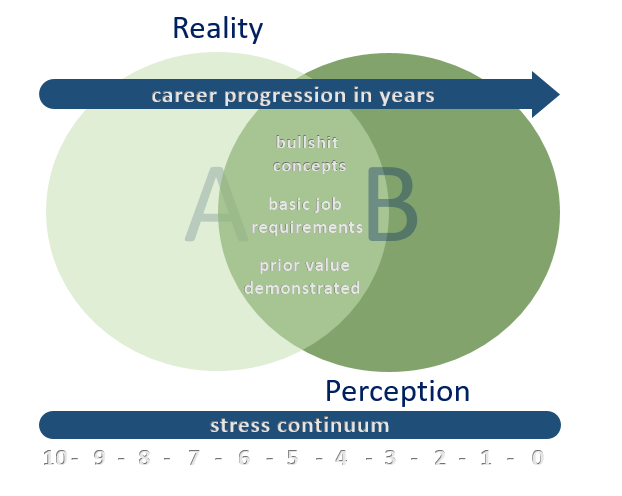 The title of this post is misleading. I know it sounds depressing. However, I wrote this as a statement of liberation. It marks the spot on my career timeline where i have given up on outcome. Although i have been slowly unplugging from work responsibilities over the prior several months — I can now happily declare, ” I am no longer concerned with measured output, deliverable, or KPIs. I now focus entirely on the perception of the value i bring to the organization.” It feels great writing that down.
The title of this post is misleading. I know it sounds depressing. However, I wrote this as a statement of liberation. It marks the spot on my career timeline where i have given up on outcome. Although i have been slowly unplugging from work responsibilities over the prior several months — I can now happily declare, ” I am no longer concerned with measured output, deliverable, or KPIs. I now focus entirely on the perception of the value i bring to the organization.” It feels great writing that down.
I speak often of my experiences in the working world, and how my struggles with depression / anxiety are an ever present factor in my life. In the past i used this anxiety to fuel me at work to rise to the occasion and deliver when others have not been able to. It is because of this self-imposed pressure that i have been able to achieve a moderate amount of career success by most organizations standards. This method has taken its toll both physically and mentally. The countless hours spent struggling emotionally to achieve ever increasing stretch goals all-the-while keeping a calm outward appearance has left deep cracks in the foundation of what makes up me. I am now at a tipping point, a hard stop, a point of diminishing return. It is time to complete the career pivot that i have started.
Reflecting on time spent following the classic emotional wrecking-ball career model of do more-to get more- to do more i have observed two distinctly different types of successful people. In addition to the stereo-typically successful type A employee — the average accomplish your task on time, work long hours and weekends only to accept more responsibility employee — there also exists type B employees. Type B employees thrive within organization without hitting their mark — somehow, they remain employed. At times, they are even highly revered with what little work they accomplish, praised.
In many instances the supervisors response to a type B employee with a marginal measurable output versus a type A employee with a good performance record is relatively the same.
The delta between is the amount of stress and emotional discomfort the type A employee experiences — it is far greater than the type B employee. He is unplugged, coasting, and stress free.
Some hard research does exist showing increased work effort is “associated with reduced well-being and inferior career-related outcomes.” Using data collected from more than 50,000 people from 36 European countries, researchers found that the harder employees worked the more likely they were to report stress, fatigue, and lowered job satisfaction. Further, they also were noted to have inferior work outcomes around job security, recognition, and career prospects. This held true even in upper-level occupations.
In simple terms — keeping up the appearance of success seems far easier emotionally than hitting any real deliverable.
How do people get away with this? More importantly, how can i get away with this? Either consciously or subconsciously they have developed and alternative skill-set; a skill-set that affords them the luxury of making a great wage, and receiving praise, all without providing equivalent effort or outcome — Sign me up.
Most of these so-called skills are no different than concepts put forth by handfuls of self-help leaders and business gurus, simple things. Publications such as Sylvia Ann Hewlett’s, “demonstrates the importance of finding a senior-level sponsor to advocate for you and your work when seeking advancement within an organization. And, Malcolm Gladwell in his 2005 best seller, The Power of Thinking Without Thinking, reinforces the belief that people formulate opinions in the first several seconds of interacting with someone.
What is put forth below are obviously gross-manipulations of these already proven sound concepts, but in each instance the outcome is the same.
It is important to note that these concepts cannot be applied until a certain amount of baseline confidence is achieved in the overall competence of an employee. Further research would be needed on the specific application of these principles to a less demonstrated demographic group. Once this core competency has been proven a handful of basic job requirements still need to be accomplished in order to maintain the baseline perception of performance and engagement. For example; approving employees time, delegating project responsibilities, performance reviews, attending meetings, etc. If tasks like these are not completed — most likely, it will be noticed. These essential duties will vary by position and company. It is important to identify and mitigate for them prior to taking the next steps.
With elementary job functions properly addressed, maintaining the picture of achievement and engagement becomes the priority. For selective deployment, three of these bullshit concepts and their general application are highlighted below:
Find an advocate:
It is always looks better when someone other than yourself hypes your greatness. It is equally good if they can cover for your fuck-ups and shortcomings. Instead of spending years convincing several upper-level managers you are doing great things you really only have to impress one — your chosen advocate. This person, of higher authority, can advertise worthiness on your behalf in a way that doesn’t sound arrogant.
When selecting an advocate i evaluate three different elements; 1- influence of the advocate — what authority does this person have and how can it be used to secure my position? 2- reputation of the advocate — is this person on the “right side” politically? (not in the broad sense, but within the organization) 3- amount of effort required to maintain the advocate relationship — Is maintaining the advocacy relationship more of a pain-in-the-ass than its total worth?
It’s important to protect and nurture this symbiotic relationship. It is fragile and finding the right balance between output and no-put can be tricky. Enough positive work must be performed to keep your advocate’s reputation in good light, but not so much work that it detracts from your own quest to fully unplug. Caution must also be exercised to divert any bad information about you, your team, or your work that may potentially find its way back to your advocate.
Do and say the right things in the presence of the right people:
Identifying who’s who within an organization is an elementary step to success for any role. Most likely, these who’s who’s are also colleagues or superiors of your chosen advocate. Once pin-pointed efforts can be made to increase your perceived value.
Stupid shit done in their presence can go a long way in validating your work ethic and overall character as an employee. Activities such as picking up trash, engaging in a motivating conversation with a subordinate, and wiping the counters clean in front of top executives can leave them with the impression that— “This guy really cares about company X more than just his position. He cares about the company and its assets, no matter how far removed from his function.”
Pay attention to conversations that may reveal interests and then study-up. Casual lunch conversations or pre-meeting discussions with this population seems less contrived if it is a topic that yields itself naturally to discussion. Identify commonalities among this group — local sports teams, industry trends, and non-frictional current events can all be great starting points.
Plan for a scapegoat:
Even in a perfect environment shit can go wrong. In this new perception only environment it is a fact that shit will indeed go wrong. That’s okay as long as you have planned for a scapegoat.
A scapegoat can be a person, however consistently blaming others within your company for your misses will make you look an asshole and this political time-bomb will certainly make its way back to your advocate eventually forcing their hand to remove you from your position. It is best to limit your “ internal individual scapegoating” to a select few — primarily those who have or will soon exit the organization. Pre-identifying process, equipment and time-based scapegoats will ensure that you are absolved of wrong doing without being painted as the organizational dickhead.
Already known process gaps, data configuration/integrity issues, vacancies in position, etc. are all easy to exploit. The weather, contractors, vendors, the mail / Fed-ex / UPS, planned objections to timelines, revisions to SOW’s, and multiple emails for clarification are also great techniques to stall and extend deadlines, throughout the project timeline,
These techniques will not be viable in every organization or applicable in every instance for all populations. I am also hyper-aware that my little experiment could go horribly wrong. I could end up unemployed, publicly embarrassed, and unable to regain employment through one of my already established professional contacts.
At the very least, this is an entertaining pseudo-science case study around emotional self-preservation.
But, at its very best, the working world will find humor in my stories and i can change my Linked-In profile page to read, “a 9-5 workday dropout documenting the tribulations of smoking cannabis as a leader in an anti-cannabis corporate environment.”

 The title of this post is misleading. I know it sounds depressing. However, I wrote this as a statement of liberation. It marks the spot on my career timeline where i have given up on outcome. Although i have been slowly unplugging from work responsibilities over the prior several months — I can now happily declare, ” I am no longer concerned with measured output, deliverable, or KPIs. I now focus entirely on the perception of the value i bring to the organization.” It feels great writing that down.
The title of this post is misleading. I know it sounds depressing. However, I wrote this as a statement of liberation. It marks the spot on my career timeline where i have given up on outcome. Although i have been slowly unplugging from work responsibilities over the prior several months — I can now happily declare, ” I am no longer concerned with measured output, deliverable, or KPIs. I now focus entirely on the perception of the value i bring to the organization.” It feels great writing that down.